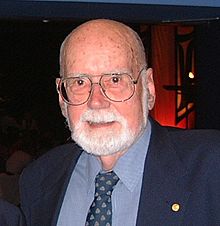E. Donnall Thomas facts for kids
Quick facts for kids
E. Donnall Thomas
|
|
|---|---|

Thomas in 2000
|
|
| Born | March 15, 1920 |
| Died | October 20, 2012 (aged 92) |
| Nationality | American |
| Alma mater | University of Texas at Austin Harvard Medical School |
| Known for | Transplantation |
Edward Donnall "Don" Thomas (March 15, 1920 – October 20, 2012) was an American doctor. He is famous for his important work in medicine, especially for developing bone marrow transplantation. This treatment helps people with serious blood diseases like leukemia.
In 1990, Dr. Thomas won the Nobel Prize in Physiology or Medicine. He shared this award with Joseph Murray for their discoveries in cell and organ transplantation. His work has saved many lives around the world.
Early Life and Education
Edward Donnall Thomas was born on March 15, 1920, in Mart, Texas. His father was a general doctor, and young Donnall often watched him work. This experience likely sparked his interest in medicine.
He went to the University of Texas at Austin. There, he earned a Bachelor of Arts degree in 1941, studying chemistry and chemical engineering. He also received his Master's degree from the same university in 1943.
While at college, he met Dorothy (Dottie) Martin, who later became his wife. They had three children together. In 1943, he began studying at Harvard Medical School. During this time, his wife, Dottie, became a lab technician to help support their family. She later worked closely with him on his research.
Developing Bone Marrow Transplants
After medical school, Dr. Thomas completed his residency at Peter Bent Brigham Hospital. He then joined the U.S. Army. His career took a significant turn in 1955 when he became a chief physician at the Mary Imogene Bassett Hospital in Cooperstown, New York.
At this hospital, Dr. Thomas began studying how to replace bone marrow. He observed experiments where rodents received high doses of radiation. These rodents could be saved by getting new marrow cells. However, when doctors tried this with human patients, they often faced problems like infections or strong immune reactions.
To understand these problems better, Dr. Thomas started using dogs for his research. Dogs were a good model because their bodies reacted similarly to humans in these types of transplants. In 1963, he moved his lab to the United States Public Health Service in Seattle, Washington. Here, he continued his groundbreaking work.
His Impact and Awards
Dr. Thomas's research led to major breakthroughs in bone marrow transplantation. This procedure involves replacing damaged or diseased bone marrow with healthy marrow cells. It is now a standard treatment for many blood cancers and other serious diseases.
His dedication and discoveries earned him many honors. In 1990, he received the National Medal of Science, one of the highest scientific awards in the United States. Later that year, he was awarded the Nobel Prize in Physiology or Medicine.
Dr. Thomas passed away on October 20, 2012, at the age of 92. His work transformed how doctors treat blood disorders and continues to save countless lives. He was also one of 22 Nobel Laureates who signed the Humanist Manifesto in 2003, showing his belief in human values and reason.
See also
- Bone marrow transplantation: Learn more about the medical procedure Dr. Thomas helped develop.
- Nobel Prize: Discover more about this famous award.
 In Spanish: Edward Donnall Thomas para niños
In Spanish: Edward Donnall Thomas para niños

